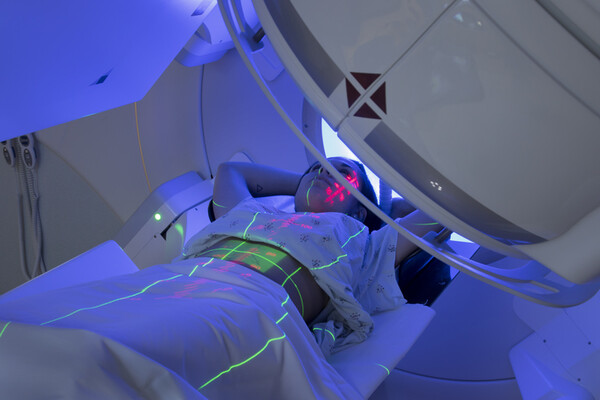
Treatment for liver cancer (hepatocellular carcinoma) varies depending on how advanced the disease is. There are standard treatments that are preferred based on the stage of the disease. Unlike other cancers, however, the location of the tumor, extent of involvement, liver function, and the patient's systemic condition all play a role in treatment decisions, making it challenging to apply a one-size-fits-all approach.
Therefore, multidisciplinary care is becoming increasingly popular. It brings together experts from various fields, such as internal medicine, surgery, radiology, pathology, and radiation oncology, to discuss the best treatment options.
In this column, I'll examine how radiation therapy is performed and when it is most effective in liver cancer.
How does radiation therapy work to treat liver cancer?

In the clinic, many patients ask if radiation therapy is a treatment that burns cancer cells to death. However, it destroys the DNA of the cancer cells, which causes the liver cancer to disappear or stop growing. When high-energy radiation is delivered to the body, ionizing radiation occurs in the body to produce these biological effects. The radiation that delivers this energy is divided into photon radiation (X-rays) and particle radiation (protons and heavy particles), and radiation therapy using X-rays is the most used radiation therapy for liver cancer.
Preparation for radiation therapy for liver cancer
For radiation therapy to work as planned, the radiation must be delivered from outside the patient's body to the liver cancer inside, which is not as easy as it sounds.
First, the liver is an organ that moves a lot with breathing, so you need to plan how to control this before treatment. There are several options to consider, such as using abdominal compression to minimize breathing movements, having the patient hold their breath repeatedly for a certain amount of time, or having the radiation delivered during certain breathing cycles while the patient breathes freely.
Computed tomography (CT) imaging is often needed for radiation therapy planning, especially in liver cancer, where four-dimensional CT scans that reflect breathing cycles are often used.
It is also important for the radiation oncologist to label the liver cancer to be treated on the CT image and delineate the surrounding normal organs. The treatment plan is then designed to deliver the optimal dose to the treated area. In the case of X-rays, the most widely used technique is intensity-modulated radiotherapy, which adjusts the dose distribution in square centimeters to deliver precise radiation.
Depending on the size and location of the liver cancer, particle beam (proton or heavy particle) therapy may be used. This therapy is characterized by the fact that most of the radiation energy is delivered and dissipated only at a certain depth in the body. Once the treatment plan is determined, the prescribed dose per day and the overall duration of treatment will be determined.
Actual radiation treatment is as important as precise planning
Depending on the extent of the liver cancer, the normal liver volume, and the distance to surrounding organs, radiation therapy can be administered in as little as a week or as long as four to five weeks. Even with the best radiation treatment plan, which considers all the aforementioned factors, a precise treatment plan can be undermined by the inaccuracy of daily radiation therapy.
The body's marked baselines need to be precisely aligned each time, the posture of the CT scan needs to be well recreated, and the patient may need to fast for a certain amount of time before each treatment, just like during the CT scan. In addition, a CT scan is taken with imaging equipment on the radiation therapy machine just before each treatment to ensure that the CT is the same as the treatment plan CT to minimize errors.
During treatment, it is also necessary to maintain your breathing control as planned. During radiation therapy, which lasts about 30 to 40 minutes, various monitoring methods are used to ensure that the treatment is completed correctly.
When is radiation therapy used in liver cancer?
In early-stage liver cancer, radiation therapy is used as an alternative when the standard treatment, surgery, or localized treatments, such as radiofrequency ablation, are not feasible. If the liver cancer is small and far enough away from surrounding organs, stereotactic body radiotherapy, which delivers high doses of radiation in a short period to maximize the effectiveness of radiotherapy, is often used and has been shown to have comparable outcomes to other local treatments.
In intermediate-stage liver cancer, transcatheter chemoembolization plays a major role, and radiotherapy may be considered if residual liver cancer does not respond to repeated embolization.
In advanced liver cancer, systemic chemotherapy is the standard of care, but radiotherapy has been used in the past to more effectively reduce vascular involvement in cases where liver cancer has invaded the blood vessels. In addition, radiotherapy to relieve symptoms of advanced liver cancer often involves metastases to other organs, and radiotherapy has been used to improve the quality of life of patients.
The future of radiation therapy in liver cancer
While the latest advances in radiotherapy technology allow for more precise treatments than in the past, there is still room for error in preparation and treatment. As more advanced technologies are introduced into treatment, radiation therapy is expected to become more precise and safer. In addition, artificial intelligence technology, which is being adopted in many medical fields, is also expected to contribute to optimizing radiation therapy.
Several studies are underway to expand the application of radiotherapy, including particle therapy, and to improve its effectiveness by combining it with other local or systemic anticancer treatments. The results of these studies are expected to further improve the prognosis of liver cancer patients by providing optimal treatment according to their condition.

